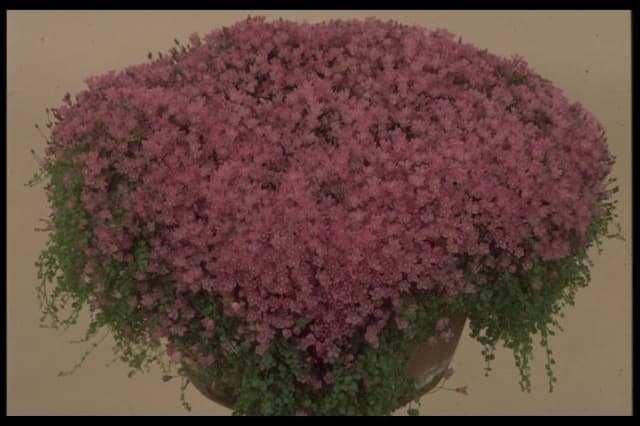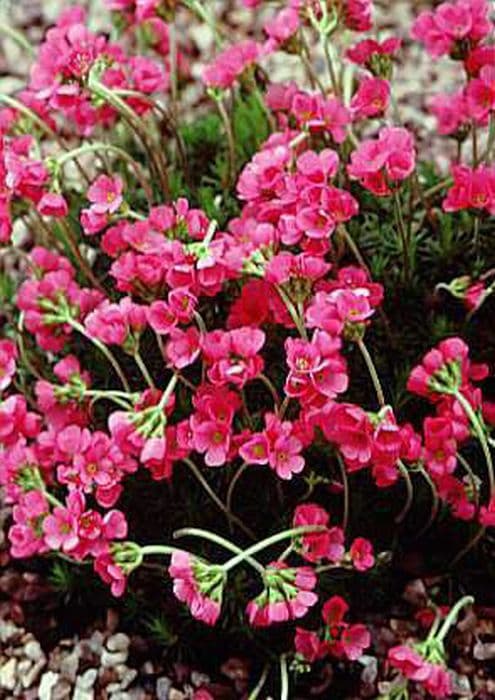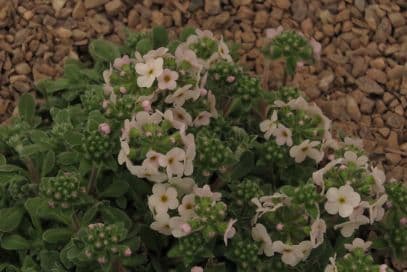Alpine Snowbell Soldanella alpina

ABOUT
Soldanella alpina, commonly known as alpine snowbell, is a charming, perennial plant often found in mountainous regions. The distinctive feature of this plant is its beautiful bell-shaped flowers, which can range in color from a soft lavender to an intense blue-violet hue, often with a fringed or toothed petal edge that adds a delicate, whimsical appearance. The leaves of the alpine snowbell are typically rounded, with a heart-shaped base, forming a low-growing rosette closer to the ground. They are a deep, shiny green, sometimes with a slight purplish tinge underneath, creating a lush backdrop for the striking flowers. As the name suggests, the alpine snowbell thrives in alpine climates and is accustomed to cooler weather and well-drained soils. Despite its delicate appearance, it is a hardy plant, capable of surviving in harsh conditions where other plants might not prevail. The blooms typically emerge in the late spring to early summer, providing a dash of color to the landscape. The foliage may persist throughout the season, offering a constant green presence. In summary, the alpine snowbell is a low-growing plant known for its rounded, shiny leaves and iconic bell-shaped, fringed flowers that captivate onlookers with their enchanting bloom colors ranging from soft lavender to deep blue-violet.
About this plant
 Names
NamesFamily
Primulaceae
Synonyms
Alpine Snowbell, Blue Moonwort
Common names
Soldanella montana, Soldanella pusilla, Soldanella carpatica, Soldanella hungarica.
 Toxicity
ToxicityTo humans
Alpine Snowbell (Soldanella alpina) is not widely documented as a toxic plant to humans. There is limited information on its toxicity or the symptoms of poisoning. Typically, if a plant is not documented as toxic, it may not necessarily be harmful; however, it cannot be guaranteed to be safe. If one were to ingest any part of the Alpine Snowbell and experience adverse effects, it would be crucial to seek medical advice.
To pets
Alpine Snowbell (Soldanella alpina) is not widely documented as a toxic plant to pets. There is limited information on its potential toxicity or the specific symptoms of poisoning for animals. If a pet ingests this plant and shows signs of distress, consult a veterinarian. Without definitive information on its toxicity, it is prudent to prevent pets from consuming plants not known to be safe.
 Characteristics
CharacteristicsLife cycle
Perennials
Foliage type
Evergreen
Color of leaves
Green
Flower color
Blue
Height
0.16 feet (5 cm)
Spread
0.33 feet (10 cm)
Plant type
Herb
Hardiness zones
3
Native area
Europe
Benefits
 General Benefits
General Benefits- Ornamental Value: Soldanella alpina, also known as alpine snowbell, is appreciated for its delicate, bell-shaped flowers that add aesthetic appeal to rock gardens and alpine garden settings.
- Biodiversity Support: It provides food and habitat for a range of mountain-dwelling insects and pollinators, enhancing local biodiversity.
- Adaptability: Alpine snowbell is adapted to high-altitude environments, making it suitable for gardens with similar harsh conditions where other plants might not thrive.
- Erosion Control: The plant helps stabilize soil in sloped alpine garden areas, contributing to erosion control.
- Low Maintenance: Once established, it requires minimal care and is relatively hardy, making it a convenient choice for gardeners.
- Edging Plant: Due to its compact growth habit, alpine snowbell is suitable for use in edging paths or garden borders.
- Early Bloomer: It is one of the early bloomers in spring, providing color and interest in the garden after the winter season.
 Medical Properties
Medical PropertiesThis plant is not used for medical purposes.
 Air-purifying Qualities
Air-purifying QualitiesThis plant is not specifically known for air purifying qualities.
 Other Uses
Other Uses- Alpine Snowbell can be used as a dye plant; the roots contain substances that can provide a reddish or orange color to textiles.
- The plant's leaves can be incorporated into potpourri for their subtle fragrance and delicate appearance in decorative arrangements.
- Its flowers, due to their bell shape, can be used as natural ornaments in miniature craft projects such as fairy gardens.
- Alpine Snowbell can be pressed and included in botanical art or herbarium collections for educational purposes.
- Because of its attractive bloom, the plant is sometimes used in thematic gardens, such as alpine or rock gardens, for aesthetic enhancement.
- Photographers and artists may use Alpine Snowbell as a subject for their work, capturing the details of its blooms in various mediums.
- Its resilient nature at high altitudes makes it a candidate for ecosystem restoration and conservation projects where native alpine flora are being reestablished.
- The flowers of Alpine Snowbell can be used for decoration on cakes or desserts when candied, being both edible and appealing.
- The plant can be studied for its cold resistance, offering insights into how plants adapt to alpine climates, potentially aiding in plant breeding.
- Collectors of rare or alpine plants might cultivate Alpine Snowbell as part of a specialized plant collection.
Interesting Facts
 Feng Shui
Feng ShuiThe Soldanella alpina, commonly known as alpine snowbell, is not used in Feng Shui practice.
 Zodiac Sign Compitability
Zodiac Sign CompitabilityThe alpine snowbell is not used in astrology practice.
 Plant Symbolism
Plant Symbolism- Resilience and Strength: Soldanella alpina, commonly known as alpine snowbell, often grows in high mountain ranges, surviving in harsh, cold conditions, which symbolizes its resilience to withstand challenging environments.
- Hope: The alpine snowbell is one of the first plants to flower after the snow melts, representing hope and the return of life after difficult periods.
- Determination: This plant's ability to grow in thin alpine air and poor soil implies a strong determination to live and thrive against the odds.
- Adaptation: Alpine snowbell has adapted to its specific ecosystem, which can symbolize the importance of adjusting to one's circumstances to succeed.
- Purity: The delicate and pure white flowers of the alpine snowbell represent innocence and purity, often flourishing untouched in their natural, serene habitats.
 Water
WaterAlpine snowbell prefers consistently moist soil, so it's important to water it regularly. During the growing season, water your alpine snowbell with about one gallon of water per week, allowing the soil to remain damp but not waterlogged. In hotter periods, check the moisture level more frequently, as you might need to water twice a week. Reduce watering in the winter when the plant is dormant, ensuring the soil doesn't dry out completely. Be cautious of overwatering to prevent root rot, which can occur if the soil is too soggy.
 Light
LightAlpine snowbell thrives in partial shade conditions, which mimic its natural alpine habitat. The best spot for this plant would be one where it receives some morning sun followed by dappled or filtered light throughout the day. It can also grow well in full shade, especially in areas with hot summers. Avoid exposing alpine snowbell to full sun for extended periods, as this can scorch its delicate foliage.
 Temperature
TemperatureAlpine snowbell is a hardy plant that can withstand cold conditions, typically surviving in temperatures down to around 20°F. Its ideal temperature range is between 50°F and 70°F for optimal growth. While it can tolerate brief periods above this range, extended exposure to heat above 75°F can stress the plant. Alpine snowbell's alpine origins mean it is well-adapted to cooler climates rather than hot ones.
 Pruning
PruningPruning alpine snowbell is mainly done to remove dead or damaged foliage and to maintain the plant's compact shape. It is best to prune in early spring, just after the last frost, which allows for new growth to fill in. Pruning is not typically needed on an annual basis, and over-pruning should be avoided to maintain the plant's natural form. During flowering, deadheading is not necessary, as the plant benefits from letting the blooms fade naturally.
 Cleaning
CleaningAs needed
 Soil
SoilAlpine snowbell (Soldanella alpina) thrives in humus-rich, well-drained soil with slightly acidic to neutral pH levels, ideally between 5.5 and 7.0. A suitable soil mix can be created by blending equal parts of peat, loamy soil, and sharp sand to ensure adequate drainage and mimic its natural alpine habitat conditions.
 Repotting
RepottingAlpine snowbells (Soldanella alpina) do not require frequent repotting as they are relatively slow-growing. Repotting every 2-3 years in spring is usually sufficient to replenish the nutrients in their soil and give their roots adequate space to grow.
 Humidity & Misting
Humidity & MistingAlpine snowbells (Soldanella alpina) prefer moderate to high humidity levels, which replicate their native mountain environments. Aim for a humidity range between 50% and 70% to maintain the optimal health of the plant.
 Suitable locations
Suitable locationsIndoor
Provide bright, indirect light and cool temps for Alpine snowbell indoors.
Outdoor
Place Alpine snowbell in dappled shade with cool, moist soil outside.
Hardiness zone
Soldanella alpina, commonly known as alpine snowbell, is suitable for USDA hardiness zones 4-7.
 Life cycle
Life cycleSoldanella alpina, commonly known as alpine snowbell, starts its life as a seed that requires a cold period to germinate, which usually occurs in late spring after the snow melts. The seedlings then develop into juvenile plants with a set of true leaves, adapting to the harsh alpine conditions. During the growing season, the plant forms a rosette of leaves and accumulates energy in its underground parts. When mature, the alpine snowbell produces characteristic bell-shaped flowers ranging from violet to purple, typically in the early summer, which then get pollinated by insects. After pollination, the flowers develop into capsules containing small seeds, which are dispersed by wind and, to a lesser extent, by water. Over the years, the plant may form larger clumps through vegetative reproduction, sustaining its population in the alpine ecosystem.
 Propogation
PropogationPropogation time
Spring
For the Alpine Snowbell (Soldanella alpina), the most popular method of propagation is by seed. The best time to sow seeds is in the spring, after the risk of frost has passed. Sowing seeds should be done in a cold frame or a greenhouse set at around 50°F (10°C) to ensure a controlled environment. The seeds should be scattered lightly onto the surface of a well-draining seed starting mix and gently pressed into the soil, but not covered, as they require light for germination. Keeping the soil evenly moist but not waterlogged is key to successfully germinating Alpine Snowbell seeds. Germination can be slow and erratic, sometimes taking several weeks to a few months, so patience is required during this process. Once seedlings have developed true leaves and are large enough to handle, they can be transplanted into individual pots and eventually moved outdoors once they are well-established and there is no longer a threat of frost.









